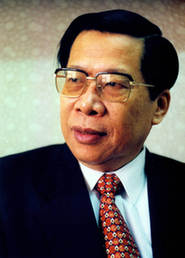Yang Weiguang, Trailblazer of China’s TV Industry
By LIU HONGMEI
Yang Weiguang, former president of CCTV, died on September 20 at the age of 79. Although Yang asked that mourning and memorial services be abbreviated, voluntary celebrations of his life continued for almost a month. This prompted many inquiries about the man who retired from the CCTV presidency 15 years ago. As posthumous reports described him, Yang was a trailblazer and trendsetter for Chinese television. For insiders, his life was a symbol of the daring period of reforms.
 |
|
The late Yang Weiguang, former CCTV president. |
Committed to CCTV
In July 1985 Yang Weiguang, then vice president of China National Radio (CNR), was appointed vice president of CCTV, responsible for the news section. He was 50 years old, an age at which the Chinese believe that risks and ventures should be avoided.
Yang had worked at the radio station for more than 24 years, and rose from a minor editor to vice president in charge of its news services. In 1985 television was still a luxury for Chinese people; radio and newspaper were the primary sources of news and information.
CCTV, China’s central television station, was still rudimentary when Yang took office. There were two channels with only 28 news stories per day. Its widely-viewed 30-minute evening news normally covered 15 stories every night, which were usually dated by the time of broadcast.
When he took his post, Yang did not give lectures or new policies like other newly-appointed officials. Instead he had extensive discussions with his new colleagues and underlings to build relationships and learn the minutiae of TV broadcasting. Two months later he presented an extensive reform plan, proposing to elevate the breadth, depth, timeliness, relevance and liveliness of CCTV’s evening news and make it more audience-friendly.
The change was swift. The 7:00 pm program was expanded to include more than 30 news stories per night, including those taking place after 6:00 pm. It soon became the preferred source of national and international news.
On January 29, 1986 the U.S. space shuttle Challenger exploded after liftoff. In the evening, Chinese viewers were shocked to see CCTV news open with a six-minute report on the Challenger accident. Previously, the station had always started with domestic news; international news was only covered in the last five minutes. It was Yang who masterminded this change, igniting a national debate and rapid changes in China’s mass media.
Later that year, CCTV made more shockwaves with a live broadcast of the National People’s Congress (NPC) Standing Committee’s debates over a proposed bankruptcy law. It was the first such broadcast in the history of the Chinese legislature.
In 1987, Yang requested permission to broadcast live the press conference during the annual sessions of the NPC and Chinese People’s Political Consultative Conference (CPPCC), China’s most important political events, an endeavor to dispel misgivings and misunderstandings about Chinese political situation and policies. After fierce debate, the bold overture was approved. For the first time, Chinese people watched their state leaders field questions and address journalists in real time. The move was hailed by the Christian Science Monitor as a significant step towards greater openness.
In 1990, when Beijing hosted the 11th Asian Games, CCTV rallied a reporting team of more than 2,000, composed of staff from local stations and college students, and gave full coverage to the first major international sporting event on Chinese territory.
